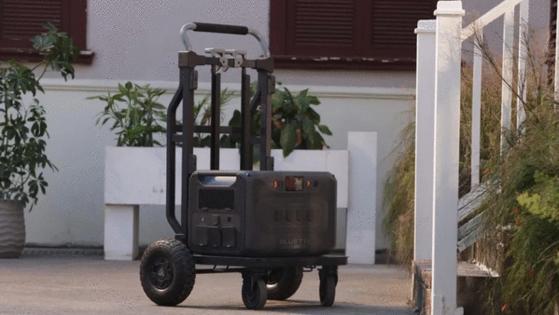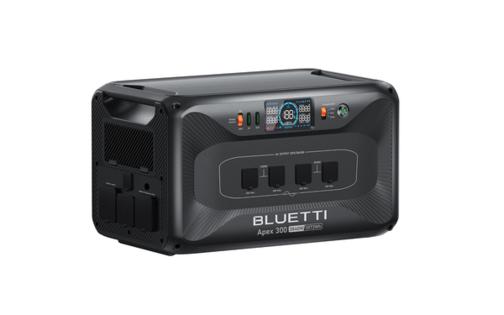Tech review: Bluetti Apex 300 is the center of a new power ecosystem
Published in Business News
I love portable power stations, and I’m really loving the evolution they are going through as batteries and inverters get better and smaller.
Today’s power stations may look similar to those of two or three years ago, but modern lithium iron phosphate batteries (LiFePO4) are so much better than previous generations of lithium-ion batteries.
Today’s LiFePO4 batteries have a lifespan of more than 10 years and thousands of recharge cycles compared to hundreds of recharge cycles and a two- or three-year life expectancy of previous generations of lithium-ion batteries.
I’ve been testing a new type of power station from Bluetti called the Apex 300 that is aimed at people who are looking for a versatile power station that can be used for portable situations or for whole-home backup power through expansion.
According to Bluetti, the Apex 300 uses second-generation automotive LiFePO4 cells that can provide 6,000 charge cycles before dropping to 80% of their battery life remaining. Bluetti estimates the Apex 300 can last up to 17 years.
The Apex 300 is also built differently. It is the first portable power station I can recall that does not have any DC outputs. There are no 12v car outlets, no USB ports. There are only AC outlets, but in a first for Bluetti, the Apex 300 can provide 120v or 240v AC power with the flip of a switch.
This means the Apex 300 can power virtually anything you can plug in, including 240v appliances like clothes dryers, well pumps and even EV chargers.
The batteries inside have a capacity of 2,764 watt-hours. You can expand that capacity by adding one or more B300K expansion batteries that each add another 2,764Wh. The Apex 300 can also work with older B300 expansion batteries.
If you’d like to connect the Apex 300 to provide whole-house backup, those expansion batteries can bring the system to a maximum capacity of 58 kilowatts of power if you connect three Apex 300s with 18 expansion batteries.
To give you some scale, the Apex 300 measures 20.67 inches by 12.87 inches by 12.6 inches, and it weighs just under 84 pounds. I’d consider the Apex 300 on the heavy side, but it is portable. I can lift it, but it would be easier to move with two people.
Bluetti does offer a foldable trolley for the Apex 300 that makes it quite manageable to move around, even with one or more expansion batteries. I was sent the trolley for review, and it is quite beefy. It includes brackets to secure the batteries so they stay in place
The Apex 300 has four 120v outlets. Each pair can provide 1,920W of output. The power station can provide a total of 3,840W of power. Of course, connecting multiple Apex 300s will multiply their output capacity.
One pair of AC outlets provides instant (zero millisecond) UPS backups. The other two outlets provide 20-millisecond UPS backups. Items, such as computers, plugged into the outlets will continue working if the power goes out.
On the side, you’ll find one NEMA TT-30R port (120V/30A) and one NEMA 14-50R port (120/240V, 50A). These are for larger appliances and connecting the Apex 300 to your home’s power panel or an RV.
What if you really need DC outputs? Bluetti kept costs and size to a minimum by leaving them out, but you can add them back with an expansion box called the Hub D1, which adds two USB-A, two USB-C, two 12v cigarette lighter ports, two DC5521 ports and a 50A Anderson port. The Hub D1 has a maximum output of 700W.
You can recharge the Apex 300 with 120V AC power (up to 1,800W). Charging from AC power should take less than an hour, but charging speeds are user selectable, so if you need to charge at a slower rate, say from a generator that has limited power, you can dial down the charge rate with a selector switch or through the app.
There are a lot of settings, especially advanced settings, available through the Bluetti app. The Apex 300 can use Wi-Fi or Bluetooth to connect to your phone, but if you really are off-grid, you don’t need to use the app at all.
There are two built-in solar inputs (1,200W max per port), but you can also add an external solar connector box (SolarX 4K) that brings the solar charging capacity up to 6,400W max.
So, what kinds of things can the Apex 300 power? Bluetti says you can power your refrigerator for up to 70 hours or your microwave for up to 10 hours. You can run a TV for up to 100 hours or your computer for up to 35 hours.
These estimates are for one Apex 300 with no expansion batteries.
Bluetti is making the Apex 300 the most expandable and capable system yet. Along with the expansion batteries, there are also 14 optional accessories to add functionality for different situations, including connecting the system to your home’s power system, connecting more than one Apex 300 at a time and charging from a variety of sources including generators and even your vehicle’s alternator.
The Apex 300 is still in pre-order on Indiegogo until July 19, where you can snag one at a pretty good discount (currently $1,399). There are various kits available that include expansion batteries and the Hub D1 or the SolarX 4K.
After the launch, retail price of the Apex 300 will be $2,399.
This is new territory for Bluetti, in that the Apex 300 is the heart of a new type of power station ecosystem, and if you see a use for it with your home or for campouts or your RV, I think you’ll love it.
©2025 Tribune Content Agency, LLC.















Comments